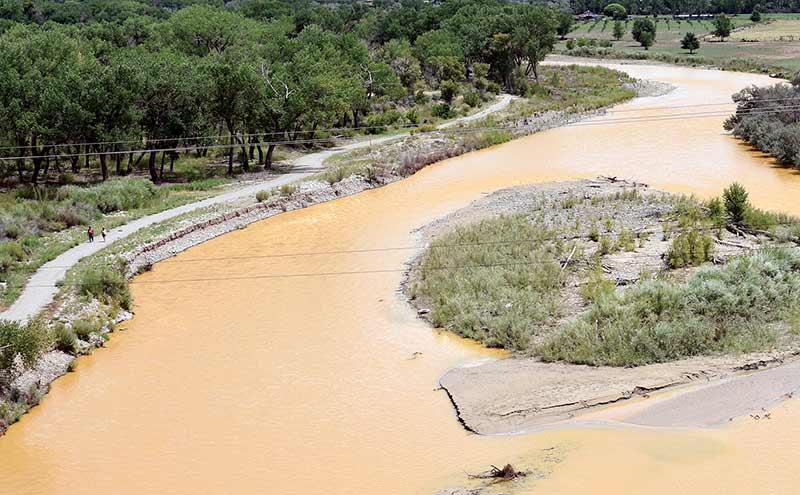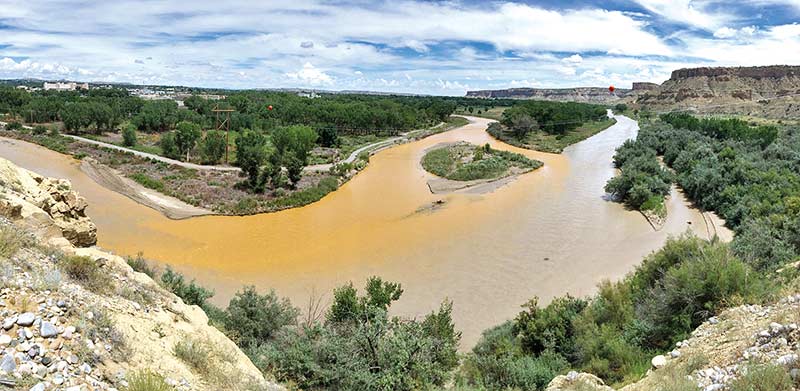
EPA final report: Water back to pre-spill state

Navajo Times File Photo A man and a woman, left, walk along the bank of the Animas River and San Juan River confluence in this Aug. 2015 file photo after a spill by the Gold King Mine.

Navajo Times File Photo
The Animas River, contaminated by an orange-colored wastewater, flows into the San Juan River in this Aug. 2015 file photo.
WINDOW ROCK
The U.S. Environmental Protection Agency today released its final report on the Gold King Mine spill, supporting earlier conclusions that water quality in the affected river system returned to pre-spill conditions shortly after the spill but also documenting spikes in contaminants when the river sediments were stirred up during snowmelt and storms.
The spill, caused when a contractor with the EPA inadvertently pierced a natural dam in the mine that was backing up water saturated with mine tailings, released three million gallons of contaminated water into the Animas and San Juan rivers on Aug. 5, 2015.
In its final analysis, the EPA said about 540 tons of metals, mostly iron and aluminum, flowed through rivers over a nine-hour period. The wastewater was released into Cement Creek near Silverton, Colorado, from which it flowed into the Animas and San Juan Rivers, ending up in Lake Powell in Page, Arizona. According to the EPA, the contaminated waters traveled a total 324 miles.

Navajo Times File Photo
A man and a woman, left, walk along the bank of the Animas River and San Juan River confluence in this Aug. 2015 file photo.
The EPA said concentrations of metals in the well-water samples collected after the plume passed did not exceed federal water drinking standards.
“No public water system using Lake Powell as a source of drinking water has reported an exceedance of metals standards since the release,” the EPA statement read.
“However, the concentrations of some metals in the plume were higher than historical mine drainage that have affected the river systems for decades,” the EPA press release stated. “As the yellow plume of metal-laden water traveled downstream after the release, the metal concentrations within the plume decreased as they were diluted by river water and as some of the metals settled to the riverbed.”
Dr. Thomas A. Burke, the EPA’s science advisor and deputy assistant administrator of EPA’s Office of Research and Development corroborated the report and said the data indicates that water quality has returned to pre-event conditions.
“(The) EPA is committed to continue our work with States and Tribes in the river system affected by the Gold King Mine release to ensure the protection of public health and the environment,” Burke said.
The report focused on understanding pre-existing river conditions, the movement of metals connected to the spill during the release through the river system, and the effects of the leak on the water quality.
The EPA added they found no evidence of fish in the river systems being killed by the 2015 spill.
Since the spill, some metals that have settled into the riverbed have contributed to exceedances of state and tribal water quality at various times for nine months and during the spring of 2016’s snow melt.
“Other exceedances may reflect longstanding contributions of metals from historic mining activities in the region and natural levels of metals in soils and rocks in the area,” the EPA stated. “(We) will continue to work with states and tribes to interpret and respond to these findings.”
To read the full article, pick up your copy of the Navajo Times at your nearest newsstand Thursday mornings!
Are you a digital subscriber? Read the most recent three weeks of stories by logging in to your online account.








 Highway 264,
Highway 264, I-40, WB @ Winslow
I-40, WB @ Winslow